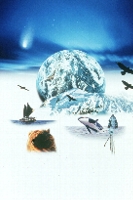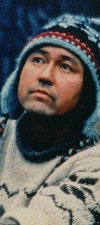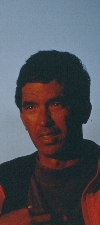
|
HOME
>
Gaia Symphony Official Guide
>
No.3 No.1 | No.2 | No.3 | No.4 | No.5 | No.6 | No.7 | No.8 | No.9 |
|
| Gaia Symphony No.3 |
|
The sound of the heavy snow is the cheering of our distant ancestors. The blue planet dancing in auroras is your spirit four thousand years in the past. The breath of the orca crossing the golden sea. The howl of the wolves echoing in the midnight sun. The tale of the raven. Yes, you are listening to them now. Through your eyes, in this moment you can see the invisible island. Don't be afraid to speak about spirit.  |
|
|
Gaia Symphony No. 3 is dedicated to the late Michio Hoshino, a photographer of Alaskan wildlife, who died immediately before the production of this film started, in which he was to appear. The film traces Hoshino's life and death while introducing people surrounding him, such as a native American storyteller, a wildlife guide, a whale researcher, a canoe builder, and others, who chose to live their lives in the rhythms of nature. Their stories eloquently illustrate the eternal cycles of life on the Mother Earth, Gaia. Freeman Dyson, an astrophysicist and a mathematician, talks about the meaning of life circulating in a cosmic scale through his broad scientific view and deep insight into human nature. Nainoa Thompson, a native Hawaiian ocean canoe navigator, expresses the importance of knowing and perpetuating the wisdom possessed by our ancestors. Gaia Symphony No. 3 depicts wondrous connections and interactions, from ancient times through the present day, between the native peoples of Alaska, Hawai'i and northern Japan all linked by the Pacific Ocean. It awakens our deeply-stored memory from over five thousand years ago, and takes our thoughts to the "mind of Gaia" and the "mystery of life." Gaia Symphony No. 3 (1997) |
|
 |
Michio Hoshino (JAPAN) - Photographer "I'm irresistibly attracted to the ideas of societies that place value on the invisible." On August 8, 1996, at the age of 44, Michio Hoshino was killed by a bear in Kamchatka, Russia. In the 20 years since he moved to Alaska, Hoshino camped alone for months on the glaciers in the cold of -40degrees and continued to take photographs of aurora as well as activities of animals in the Arctic region, such as whales, bears, and caribou. In his eyes, one could see the awe and love he had for the great and eternal life, which is carried on without interruption, transcending the physical death and differences among species. In the traditional myths passed down from generation to generation by the Alaskan native elders, he found wisdom that enables human beings to live in harmony with the workings of nature that operates on a universal scale. Hoshino had embarked on a journey to discover ways to pass on that wisdom to future generations. |
 |
Freeman Dyson (USA) - Astrophysicist "It is quite reasonable to believe that the universe has a mind." Born in 1923, Freeman Dyson was only 24 years old when he discovered the equation to unify relativity theory and quantum mechanics, and became a young professor of physics at the Institute for Advanced Study in Princeton. The works and accomplishments in his career encompass all fields, ranging from hard-core science to philosophy, arts, and religion. Among them, the Orion Project, which proposed space flight using nuclear pulse propulsion, is well-known. In contrast to Freeman who focused on a futuristic vision and outer space, his only son, George, chose to explore the wisdom of the past at the age of 16 and lived in deep nature on the Hanson Island on the Canadian Pacific coast, designing ocean-going kayaks based on models from the Aleut people in Alaska. The conflict between father and son is described in the book, "The Starship and the Canoe" by Kenneth Brower. The filming of Freeman and George took place on that beautiful island, where the two had made a dramatic reconciliation. |
 |
Nainoa Thompson (USA) - Ocean Canoe Navigator "I want children to challenge themselves and to voyage to islands they can't see." Born in Hawai‘i in 1953, Nainoa Thompson revived in the modern world the traditional Hawaiian canoe voyage across the ocean without resorting to the aid of modern navigational equipment. He was the first native Hawaiian to successfully navigate the 5,000 km from Tahiti to Hawai‘i on the Hokule‘a, a traditionally-built ocean canoe, by reading the stars and feeling the waves and wind. The success of his navigation led to a renewed sense of courage and cultural pride among native Hawaiians, and greatly contributed to the Hawaiian movement to rediscover the advanced technology and spiritual civilization of their ancestors, who lived in harmony with the magnificent workings of nature. Nainoa believes that the most important thing for the children of the 21st century is to foster the "power to see the invisible island." |
Copyright Jin Tatsumura Office |
|